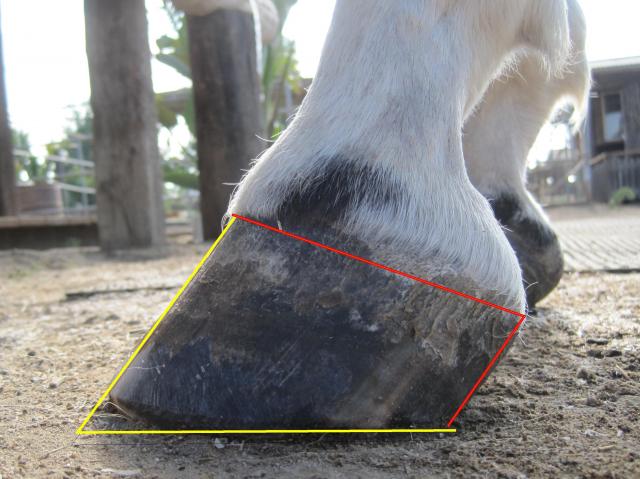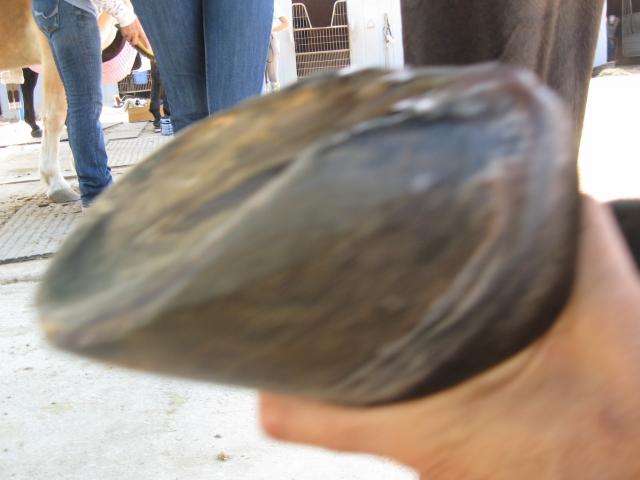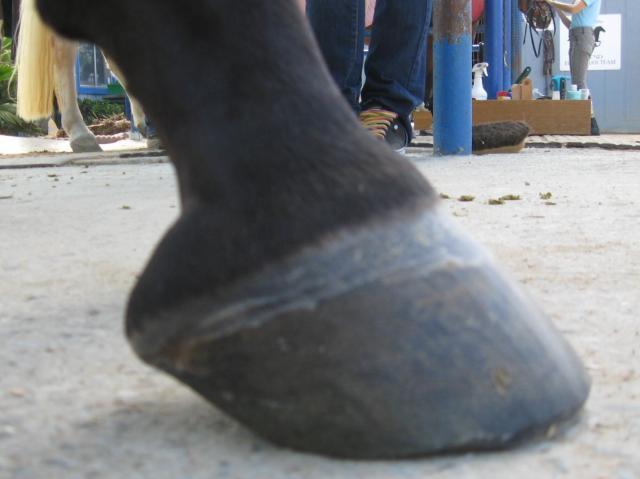I’ve yet to mentor an aspiring trimmer who didn’t wish aloud for a hard and fast, always-and-never guide for trimming. Yep, that sure would make it easier! But we’re working with a living thing…an amazing feat of natural engineering, for sure, but one that, within that marvelous design, will offer an infinite combination of variations within the normal range. Add to that: long-existing pathologies, traumatic injury, compensation for conformation quirks above the hairline, and other anomalies. The bottom line is, you’re bound to be faced with but a handful of ideal feet that would fit such a standard protocol.
Probably the one aspect of trimming with the most exceptions to any rule is heel height. Ideal palmar angle is considered to be anywhere from 0 – 10 degrees. So how do you decide what’s right for this horse, right now? In many cases, you won’t have radiographs to guide you, and even if you do, it may take some time to achieve that ideal. In their Hoof Rehabilitation Protocol, Dr. Debra Taylor and Pete Ramey recommend no more than “10mm maximum change [relative to the toe] to heel height at one session”.
The standard guidance in the absence of radiographs is to use the live sole plane in the heel triangle as a guide, and trim the heels to about 1/8″ inch above sole plane. This is an excellent parameter, and probably the best standard out there. But it’s still not that simple.
 This foot clearly needs a lot of work, but bringing it within
This foot clearly needs a lot of work, but bringing it within
ideal parameters won’t happen in a single trim.Here is a list of factors to consider when establishing heel height.
1. Dorsal angle
Okay, I put that one first because I couldn’t wait to hear the collective groan! But here’s the thing: dorsal angle is a very real parameter, and one that many barefoot hoof care paradigms tend to ignore. That might be because there are a couple of fundamental problems with the traditional approach to creating appropriate dorsal angle. One problem is the practice of achieving that angle by thinning the hoof wall. The other is the failure to recognize dorsal flare, and trying to fix the imagined low angle by growing heel.
It is generally agreed upon that 55 degrees is the average healthy dorsal angle for front feet. Some barefoot protocols prescribe a much lower angle, and you’ll have to decide for yourself which way you lean, but I personally side with the preponderance of credible research, which dictates between 50 and 55 degrees for the front feet.
2. Hairline angle
Again, there are different opinions as to what constitutes a healthy hairline angle, ranging from 20 to 30 degrees. I’ve seen enough research supporting an angle closer to 20 degrees, and enough robustly healthy feet that demonstrate it, so I’m inclined to be satisfied with something in the 20 degree area. It’s probably safe to look for something in between the two.
 This foot has about a 54 degree dorsal angle, a 20 degree hairline angle,
This foot has about a 54 degree dorsal angle, a 20 degree hairline angle,
and a 49 degree heel angle. This somewhat contracted heel looks high,
but lowering it would create a broken back hoof/pastern axis.3. Contracture
Contracted heels will generally look longer, and the foot more upright, than ideal. Take this into consideration, and don’t try to force them shorter. This is a good time to use collateral groove depth as your ultimate guide. Work on encouraging the heels to open by aggressively treating for thrush, and getting the horse moving properly as much as possible.
4. Live sole plane, +1/8″
This strategy is going to work well for many horses. But don’t make the mistake of trimming to live sole at the heel, and then trimming to calloused sole in the front of the foot. If you have a half inch of callous in the front of the foot, but exfoliate down to waxy sole at the heel, you could easily imbalance the foot.
Trimming to live sole plane +1/8″ probably won’t work for horses with unhealthy frogs, or underdeveloped/weak digital cushion.
5. Collateral groove depth
Collateral groove depth at the heel is a great way to gauge heel height. 5/8″ to 1″ works in most cases. But that 3/8″ difference can make or break a horse’s comfort, so it’s important to weigh all of the other factors.
6. Widest part of the frog
While this is a good goal to keep in your mind, it’s a pretty subjective guideline for pathological feet. Overgrown frogs will have you leaving too much heel. And in many horses with underrun feet and crushed heels, you’d be bringing the heel much too short.



 This navicular horse’s heels are almost in the middle of her foot.
This navicular horse’s heels are almost in the middle of her foot.
Because the foot is overlong all the way around, it was possible to trim her
within an 1/8″ of live sole without creating a negative palmar angle.7. Comfort
This one sounds obvious, but it can present a bit of a conundrum if you’re working to change a problem foot. Sure, if you leave a mile of heel, the horse might be more comfortable for now, but in most cases, that is ultimately not a healthy trim. The key, then, is to do everything you possibly can to make the correct trim comfortable for the horse. That means eradicating thrush, first and foremost. Don’t underestimate the discomfort even a little bit of thrush can cause in a bare hoof. It may also mean boots and pads ’round the clock.
Ultimately, if you try one approach, and it leaves the horse very uncomfortable and toe-walking, you’ve taken too much too soon. Re-evaluate, and try something different. I hope this arms you with a little more information upon which to base your heel height decision!










